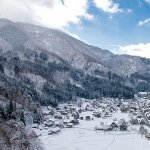Prefectural Earthquake Disaster Prevention Day in Gifu Date in the current year: October 28, 2025
 Earthquake Disaster Prevention Day in the Japanese prefecture of Gifu is observed annually on October 28. It was established to commemorate the victims of the disastrous Mino–Owari earthquake that occurred on October 28, 1891.
Earthquake Disaster Prevention Day in the Japanese prefecture of Gifu is observed annually on October 28. It was established to commemorate the victims of the disastrous Mino–Owari earthquake that occurred on October 28, 1891.Japan is situated in a volcanic zone of the so-called Pacific Ring of Fire, which results in a high seismic activity in a region. Every year, over a thousand earthquakes are recorded in Japan, some of them with magnitudes 4 to 6. Minor tremors in different parts of the country occur almost every day, and most people don’t even pay much attention to them. Due to frequent earthquakes, Japan is the world leader in earthquake prognosis and consequence management.
Earthquakes have been recorded in Japan throughout most of its written history, but their systematic study began in earnest during the Meiji era, when the eponymous emperor of Japan initiated the industrialization of Japan and encouraged the adoption of Western ideas. Although the Mino–Owari earthquake was a real tragedy, it provided data for scientific studies and greatly contributed to the development of seismology in Japan.
The Mino–Owari earthquake, also known as the Nōbi earthquake, the Great Nōbi earthquake or the Great Gifu Earthquake, is one of the biggest earthquakes in Japanese history, as well as the strongest inland earthquake to have occurred in the country. Its epicenter was located in what is now the city of Motosu.
The earthquake occurred at 6:38 AM on October 28, 1891. Surface faulting stretched 50 miles (80 km) with vertical slip in the range of about 6.5 to 10 feet (2–3 m) and horizontal displacement up to 26 feet (8 m). After analyzing the destruction caused by the earthquake, seismologists concluded that it had a surface wave magnitude of 8 (for reference, the most powerful earthquake ever recorded, the 1960 Valdivia earthquake in Chile, had a magnitude of 9.4–9.6).
The Mino–Owari earthquake caused heavy damage in the prefectures of Aichi and Gifu, as well as affected the neighboring prefectures of Fukui and Shiga. The most heavily damaged cities were Gifu and Ogaki, largely due to the subsequent fire; Nagoya and Osaka were significantly affected as well.
According to records, the Great Gifu earthquake killed more than 7,000 people and injured over 17,000. It destroyed approximately 140,000 buildings, knocked down and damaged numerous trees in the mountains, and caused a big fire in Gifu and the surrounding area. The disastrous consequences of the earthquake – in particular, the huge number of destroyed buildings – led to the increased interested in earthquake-resistant construction in Japan, eventually making the country one of the leaders in the field.
Prefectural Earthquake Disaster Prevention Day in Gifu was created to honor the memory of the Mino–Owari earthquake victims, as well as to highlight the importance of seismological research and timely and correct response to earthquakes, tsunamis and other natural disasters.
In addition to Earthquake Disaster Prevention Day in Gifu, Japan also observes nationwide Disaster Prevention Day (September 1, the anniversary of the Great Kantō earthquake), and Tsunami Readiness Day, which was added to the list of United Nations observances in 2015.
- Category
- Ecological Observances
- Country
- Japan
- Tags
- Prefectural Earthquake Disaster Prevention Day in Gifu, observances in Japan, Mino–Owari earthquake, Nōbi earthquake